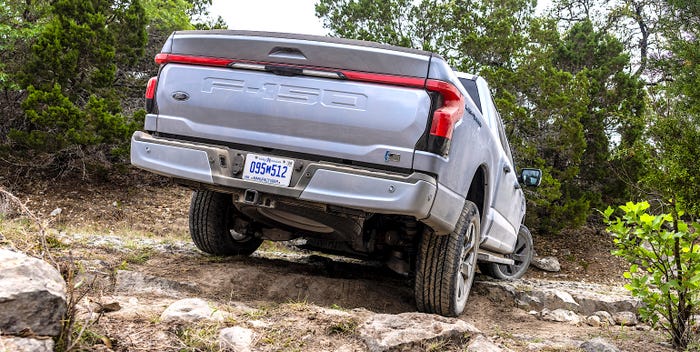EV Year in Review: Vehicle Electrification Got Pushback in 2023
In the EV sphere, downsized battery projects and concerns about buyer appetite raise questions as to whether ambitious goals could be met.
January 2, 2024

The shift to electrification and battery power received pushback in 2023. Planned battery projects got downsized. Some production plans were reduced. There were many questions about whether ambitious goals could be achieved.
“We’re paced by the customer,” General Motors CEO Mary Barra said at an Automotive Press Association event in Detroit in early December. “EVs have to be beautiful, they have to be affordable. It’s going to have ups and downs.”
EV demand is slowing
GM has not gotten its Ultium EV battery production up to full speed. The automaker said its output of EVs is slowing because customer demand is slowing.
GM is not alone.
Ford Motor Co. announced in February a $3.5 billion battery plant investment at Marshall, Michigan. The project would create 2,500 new jobs.
At that time, the company said the Marshall project would add about 35 gigawatt-hours of new battery capacity per year that would be capable of powering about 400,000 future Ford EVs.
In November, Ford said the battery operation is going ahead but will be smaller. The capacity is being pared to 20 gigawatt hours.
“We are pleased to confirm we are moving ahead with the Marshall project,” Ford said in a short statement in November. “However, we are right-sizing as we balance investment, growth, and profitability. The facility will now create more than 1,700 good-paying American jobs.” Ford is looking to start producing battery cells at the Michigan facility in 2026.
Ford also is reducing production of F-150 Lightning electric trucks by half in 2024 because of lagging demand, Automotive News reported in December, citing a memo sent from the automaker to a supplier.

Ford has announced it cutting F-150 Lightning production in half in 2024 due to lagging demand. Credit: Ford Motor Co.
Ambitious goals; consumer concerns
The shift to electrification has been fueled by governments worldwide as part of efforts to reduce greenhouse gas emissions. Automakers have set ambitious goals for going electric. GM, for example, wants its fleet to be all-electric by 2035.
In 2023, consumers seemed to tap on the brakes. There remain concerns about the range between charges and the ease of finding recharging facilities.
To be sure, there have been advancements in boosting the range between charges. As EV adoption increases, the price difference between electric and traditional internal combustion engine vehicles may narrow.
But some analysts say automakers will find it difficult to meet their EV targets under almost any circumstances.
“That is not possible,” Casey Selecman, director of powertrain forecasting at Auto Forecast Solutions, said in May of automaker EV targets.
Selecman spoke at the grand opening of the Michigan Technical Center of YCM Alliance in Sterling Heights, Michigan.
The forecaster said supplies of key materials such as lithium, cobalt, and nickel will hold back the expansion of EV production.
“We’re going to see massive price increases in lithium,” he said. “We’re going to see shortages in lithium.”
Auto Forecast Solutions estimated that to meet automaker targets, EVs would have to account for 92% of vehicle output by 2040. The forecasting company said 55% might be more reasonable, Selecman said.
“That may be a bit of a stretch,” he said at the May event.
At the same time, the forecaster said automakers will need to maintain internal combustion engine (ICE) know-how. “There’s a tremendous risk in not holding onto that ICE expertise,” he said.
In the U.S., the progress of electrification may depend on the 2024 presidential election.
The Biden administration is supportive of the shift to EVs. However, former President Donald Trump, running for another term in 2024, isn’t a fan of electrification. He’s in the ICE camp.
At the December Automotive Press Association event, GM chief Barra fielded a question about that.
“We’re going to be customer driven, not regulatory driven,” she said. “We can’t change every four years based on what’s happening in D.C.”
‘We’re still in the first lap’
2023 wasn’t all gloomy for vehicle electrification.
Stellantis, the European-based automaker that owns the former Chrysler Corp., agreed to reopen a Belivere, IL, factory as part of negotiations with the United Auto Workers union. The union went on strike at some operations at Stellantis, GM, and Ford simultaneously.
When the walkouts concluded, Stellantis agreed to produce a new truck model at the Illinois plant. The company also agreed to install a new battery operation at Belvidere. The Detroit-based union said Stellantis will invest $1.3 billion at the Illinois complex for battery production, which would create another 1,300 jobs.
The UAW said the new battery operation in Illinois would be a joint venture while battery workers would be Stellantis employees leased to the joint venture.
All of this points to a mixed situation (at least) for electrification. Amid the EV pushback, there’s a lot to be decided.
“We’re in the early days,” GM’s Barra said about the shift to EVs. “We’re still in the first lap. The customer is rational. This is really an expensive purchase for them.”
At the same time, she added, “You want to move to EVs as soon as possible.”
About the Author(s)
You May Also Like





